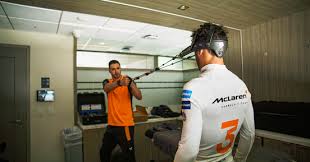
Brutal training
Training for Formula 1 drivers is intense and highly specialized, focusing on both physical and mental conditioning to meet the sport’s extreme demands. Drivers follow rigorous fitness routines that target neck, core, and cardiovascular strength to withstand high G-forces and maintain focus over long races. Neck training is especially critical, as drivers endure lateral forces of up to 6G in corners. Reaction time and hand-eye coordination are sharpened through reflex drills and simulator sessions, helping drivers respond instantly to high-speed situations. Mental endurance and stress management are also key, as drivers must stay calm and make split-second decisions under pressure. Combined with strict nutrition and hydration plans, F1 training is a full-time commitment aimed at keeping drivers in peak condition throughout the season.